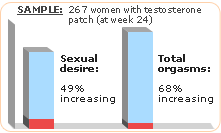A recent study suggests that use of a testosterone patch may help increase libido in postmenopausal and especially surgically menopausal women. Low libido, or “hypoactive sexual desire disorder” is defined as a persistent lack of sexual desire and inability to become aroused during sexual intercourse.

Evidence suggests that the condition in women is linked to low levels of testosterone. The ovaries and adrenal glands are primary producers of testosterone in women, but during menopause this production significantly decreases, especially in surgically menopausal women, who may experience a 50% decrease in testosterone levels after surgery.
Estrogen therapy can help to treat sexual dysfunction including vaginal dryness and vaginal atrophy after oophorectomy, but this alone will not necessarily relieve loss of libido. It appears that sufficient quantities of testosterone are also paramount for women to preserve healthy sexual activity.
Different kinds of testosterone therapy have been studied for women with hypoactive sexual desire disorder, like oral administration (pills) and injections. John Buster et al performed a study published in the journal Obstetrics and Gynecology testing the efficiency of a low-dose testosterone patch, and conclude that this is a particularly useful choice for alleviating low libido in postmenopausal women.
The study consisted of 533 women who suffered from loss of libido after undergoing hysterectomy and oophorectomy, and had already been receiving estrogen therapy for the past 3 months. Subjects were all in a monogamous, long-term relationship with a sexually available partner. 266 women were placed in the control group, while 267 test subjects were given the testosterone patch.
Results were tested by having the women write a Sexual Activity Log diary over a 24 week period, to be measured against the Profile of Female Sexual Function, which measured 7 separate types of sexual function: sexual desire, sexual pleasure, sexual arousal, orgasm, sexual responsiveness, sexual concerns, and sexual self-image. Blood tests checked testosterone and estrogen levels. Patients were also monitored for androgen affects such as facial hair, acne, and headache.
The researchers concluded that the testosterone patch produced considerably positive results in terms of augmenting libido after 24 weeks. Maximum results were noted after 12 weeks and were sustained through the rest of the 24-week period. By week 24, women in the test group observed improvement in all 7 categories of sexual function. Sexual desire increased on average by 49%, while total orgasms increased 68%.
Average unfavorable side effects included headaches, increased facial hair, and skin reaction to the application of the patch, but incidence was uncommon and reported as tolerable. Furthermore, because the study lasted only 24 weeks, safety of the treatment beyond this period cannot be certain. It should also be kept in mind that test patients were also under estrogen therapy, which may have guarded against some of the androgen affects of testosterone.
The testosterone patch is most likely superior to other modes of testosterone therapy (implants, injections) because the patch is able to deliver constant and controlled amounts of the hormone. Postmenopausal women (especially those who have undergone surgical menopause) who suffer from their loss of libido may want to discuss this treatment option with their doctors.